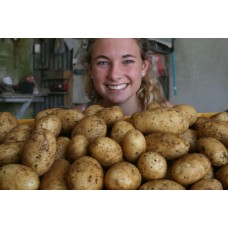Availability: In Stock
Ideal for mashing, boiling & microwaving
Enjoy the skin too: many of the nutrients are in the skin
Potatoes are the best source of potassium of any fruit or vegetable - potassium plays a major role in reducing the risk of heart attack and stroke, two of the biggest killers of New Zealanders, also combats high blood pressure
These good all-rounders have moderate starch content & are not too floury, not too waxy - they sit between the two ends of the spectrum.
White skinned, white flesh with shallow eyes.
Oval to long oval shape.
Direct from our well established, second generation potato grower
Energy; Fibre; Potassium; Folate
Potatoes are the number one vegetable in New Zealand with 97% of us eating them. 53% of New Zealanders consume fresh potatoes four times per week & 21% of New Zealanders eat them daily.
Potatoes are often perceived as unhealthy because they have a reported high glycaemic index (or GI).
HOWEVER, many nutritionists now believe the glycaemic index is not a very useful measure because it is a ratio that refers to the digestibility of carbohydrate relative to glucose, & does not reflect the density of carbohydrate in the food or the amount of food eaten to achieve a blood glucose response.
Glycaemic impact is a new way of measuring blood glucose response to food.
The advantage of this measure has gram units & can be expressed as g/100g of food or g/serving of food, just like other nutrients on a food label.
Potatoes are in fact an excellent source of low-density energy.
This means that the energy we get from potato comes from carbohydrate (17kJ/g) rather than fat (34kJ/g) & is diluted about eight times with water.
They are also a good source of vitamin C, a source of potassium & niacin, & if you keep the skin on a source of dietary fibre.
The glycaemic impact of potato is easy to manage in a healthy diet.
When potato is cooked the starch gelatinises & becomes digestible.
But when you cool cooked potato & let it stand for a while the starch chains partially join up, & this slows down the speed they are digested.
So starch in cold cooked potato is digested at a lower rate than in the hot potato, & correspondingly has a lower glycaemic impact per weight.
So potato is not the villain it has been made out to be because it is not carbohydrate dense.
Click Here:
Vegetable Sunset Soup Recipe
Nutrition Information
Serving size: 1 potato - 150g
Percentage Daily Intakes are based on an average adult diet of 8700 kJ
Your daily Intakes may be higher or lower depending on your energy needs.
*Recommended Dietary Intake (Average Adult)
**There is no labelling RDI for potassium but a claim can be made if a serve contains 200mg or more
+ Estimated Safe and Adequate Daily Dietary Intake
Source: The Concise New Zealand Food Composition Tables, 12th Edition, Plant & Food Research - 2018








